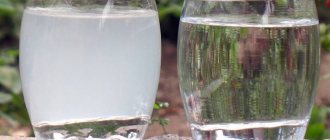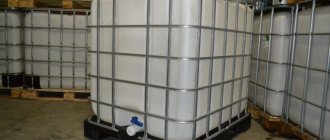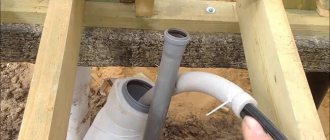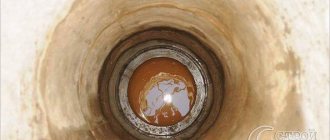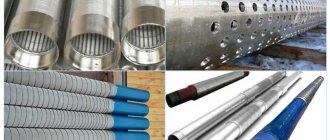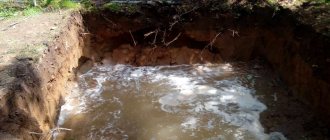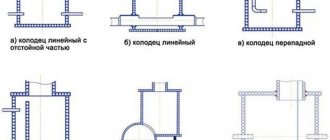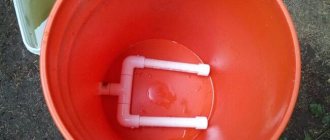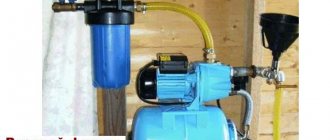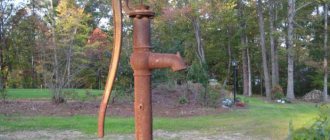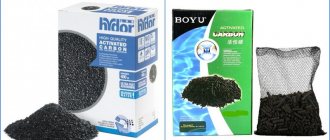A bottom filter is a mound made of several layers of different natural materials that are resistant to erosion by water. Passing through a bottom filter for a well, the water is purified from large debris, suspended particles and some organic impurities.
If a floater appears during the process of digging a mine, then to contain the soil saturated with water, it is worth making a filter embankment or shield. But sometimes, even in the absence of quicksand, it is proposed to create such an embankment. Is a bottom filter always needed in a well? "Plumber Portal" will help you understand this issue.
Functional purpose of the bottom filter
A bottom filter is a layer-by-layer embankment made of various natural materials that are not washed away by well water. Water passing through the filter is cleaned of debris, harmful impurities and suspended particles present in the well.
The installation of a bottom filter is mandatory in the following cases when:
- it is necessary to protect the bottom of the well from erosion;
- water flows under high pressure;
- at the bottom of the well there is fine or dusty sand;
- the well is opened by quicksand;
- protection of pumping equipment sensitive to clogging is necessary;
- the water level in the well is characterized by large differences, for example, during pump operation or precipitation;
- water quality is unsatisfactory: turbidity, sediment, unpleasant odor. You can read more about the causes of unsatisfactory water quality and how to eliminate them in this material.
Installing a bottom filter is not necessary if the well has exposed hard, fractured clay or rock formation. Do not use bottom protection if the water comes from natural springs. If the dense bottom of the well is not clogged with impurities and suspended particles, additional filtration is not necessary.
In other cases, to obtain high quality water, installing a bottom filter for a well is a mandatory step.
In most cases, wells require a bottom filter to purify the incoming water and improve its taste.
Installation of the finished structure
Fixing the shield at the bottom of the well with pebbles
Small holes are made in the walls of the shield for water to enter. It is advisable to make the base of such a design on bars, no more than 7 cm long. They will serve as “legs” through which liquid circulates better.
Whatever the type of wood used to make the shield, over time it will be destroyed by water, which can negatively affect its taste. In such cases, the bottom of the shield should be periodically replaced with a new one.
A reverse bottom filter is applied to the surface of the shield as follows:
- large fraction stones;
- medium-sized materials;
- small fraction.
Strong quicksand can lead to the shield being sucked into the soil, which is why it should be reinstalled every 5 years.
Metal bottom device
Metal mesh can be an excellent treatment plant for a well. Its main advantages are:
- reliable filtration of sandy debris;
- high level of strength;
- does not impair taste characteristics;
- durability.
It is more practical to use a stainless steel mesh, where the cell size does not exceed 2 mm.
This design is installed between metal circles at the level of the backfill layer of large stones. Be sure to attach the mesh to the walls of the well with pins. The components of the selected filter are placed on its surface. The average lifespan of this design is 7 years.
Installation of a soil filter at the bottom of a well
An effective bottom filter cannot be created using only one of the materials described above; the best option is to create a multilayer filter using several types of materials of different sizes.
There are two types of filter installation: direct and reverse. The choice of one type or another depends on the soil lining the bottom of the well and the pressure of the incoming water. In 9 out of 10 cases, a more efficient reverse filter is used.
Direct backfill option
A three-layer direct filter is a type in which the material of the largest fraction is at the bottom, then there is a middle layer - the size of the fraction is 5-7 times smaller than the first layer, and at the top the third layer is quartz sand or small river pebbles. The thickness of each layer should be 15-20 cm, which means that the entire filter will occupy 50-60 cm of the depth of the well.
To prevent smaller backfill from seeping into the lower layers, they must be compacted as much as possible before forming the next layer
Procedure for installing a direct bottom filter:
- preparing the bottom of the well : removing debris, silt and other contaminants;
- filling the bottom with a layer of 15-20 cm of coarse fraction: jadeite, zeolite, large river or sea pebbles;
- backfill material of the middle fraction: river or sea pebbles, medium gravel, fine zeolite, shungite;
- formation of the top layer of fine fraction: quartz sand, small pebbles.
The direct filter is used on floating soils (together with a shield), as well as on sandy and loose soils with a low pressure of incoming water. In this case, the main function of the direct filter is to carry out step-by-step water purification.
Reverse installation scheme
A return filter is a type of well filter in which the installation is carried out in layers from fine material to larger filter elements. The main function of the return filter is to prevent fine debris and sand from penetrating into the upper layers. The return filter protects the bottom of the well from erosion. It is used on sandy and sandy loam soils with calm water flow.
Procedure for installing a return bottom filter:
- Preparation of well and bulk materials.
- Filling of the lower fine-grained layer: quartz sand, small pebbles.
- Filling of the middle fraction layer: river pebbles, gravel, zeolite, shungite.
- Coarse layer filling: large stones over 5 cm, jadeite, pebbles, geotextiles.
As with the installation of a direct filter, the thickness of each layer should be 15-20 cm. All bulk materials must be washed with running water to remove clay particles and organic contaminants before placing them in the well.
The return filter is simpler to construct, it does not require compaction; heavier rocks located on top will independently compact the smaller lower materials
What materials can be used?
Let's get acquainted with the materials that can be used when arranging a bottom filter. These include:
- sand;
- jade;
- pebbles;
- shungite;
- crushed stone;
- gravel.
Prohibited materials
The fine fraction backfill is river sand . It is mined, as you probably already guessed, in quarries located on the river bed. Good sand contains a lot of quartz, but, on the contrary, there is little silt, clay and other impurities. For the material to be such, it must be properly prepared before filling it into the well.
How is river sand mined?
Step 1. To begin with, sand is poured into a large container about 1/3 full.
Step 2. Then the sand is filled with a large amount of water.
The sand needs to be filled with water
Step 3. Sand and water are mixed with a stick until a mass of homogeneous consistency is obtained. Then you need to wait 30-60 seconds for the impurities to float to the top and the heavy sand to sink to the bottom of the container. After this, the water is carefully drained.
Step 3. The procedure must be repeated up to 3 times (the exact number depends on the condition of the sand). The output is washed and ready-to-use material.
river sand
On a note! Sometimes geotextiles are used instead of sand - they are laid on or under the backfill (this depends on the type of bottom filter, we discussed this above).
Pebbles are rounded pebbles that became such as a result of colliding with each other on the shore of a reservoir or at its bottom. The size of the pebbles varies between 1-15 cm, and therefore it can be used for both fine-grained and coarse-grained layers. The material has no problems with background radiation, so use it without any fears. But before backfilling, the pebbles should be washed in the same way as river sand.
Pebbles of large fraction
Medium river pebbles
As for gravel , it is a sedimentary rock and is used for the middle fraction layer. Gravel is porous and loose, it can absorb various substances, and therefore is a kind of adsorbent in the filter. But this is also a drawback of the material - the backfill must be changed periodically so that it does not “share” absorbed substances with water.
On a note! When buying gravel, be interested in its place of origin. Do not buy used gravel, because you do not know what it has absorbed during this time and how this will affect the quality of well water.
River gravel
Crushed stone is obtained by crushing rocks and metallurgical waste. The material in the filters is used as coarse backfill (bottom or top). When purchasing crushed stone, be sure to inquire about the presence of a certificate that confirms its environmental safety.
Photo of crushed stone
Shungite is also a rock, but has a different origin - in the past it was bottom organic sediments. Shungite is gray or black in color and is an excellent adsorbent. It is used, like gravel, as backfill for the middle fraction. It purifies water by absorbing harmful substances, and therefore needs to be changed regularly. Shungite must be washed before filling or, alternatively, filled in and not used for a while (about 24 hours) in the well so that the shungite dust settles to the bottom.
Shungite
On a note! Be careful when buying shungite - sellers often pass off shungite as it. Both materials look the same, but the second does not have useful adsorbing properties.
And the last material is jadeite . It is an aluminum-sodium silicate and has a greenish color, like jade. Used in filters for the middle fraction layer. It does not react chemically with water, which is good. As a rule, jadeite is purchased for sauna stoves, and therefore you need to look for it in the appropriate departments of construction stores.
Jadeite stone
Video - How to equip a bottom filter with shungite
Wall filter in a well
In the case when the flow of water entering the well is very weak, and filtration is also carried out through its walls, then installing a bottom filter is not advisable. In such a situation, the best option would be to install a wall filter.
To make a wall filter, it is necessary to cut V-shaped holes located horizontally in the very bottom part of the well (the lower reinforced concrete ring), where filter elements made of coarse-cell concrete are installed.
Concrete for filters is prepared using medium-fraction gravel and cement grade M100-M200 without adding sand. The cement is diluted with water until the consistency of the mixture becomes creamy, after which pre-washed gravel is poured into it and mixed thoroughly. The resulting solution is filled into the cut holes and left until completely hardened.
The size of gravel for the solution must be selected taking into account local hydrogeological factors: the finer the sand fraction in the well, the smaller the size of the gravel
Caring for the bottom filter
Once you have installed a bottom filter in your well, do not forget to clean it at least once a year. In addition, do not forget to regularly carry out preventive disinfection of water in the well.
The technology for cleaning the bottom filter consists of the following steps:
- Removing filter elements and bottom shield from the well.
- Cleaning the bottom shield or replacing it.
- Flushing or replacing excavated rocks.
- Laying materials in the same order.
Timely cleaning of the bottom filter will help maintain conditions for drawing clean water from the well all year round.
How to make filter shields with your own hands
Wood
You will need about one cube of board. The tree must be chosen carefully:
- Aspen is the best material. It does not rot, even if it is constantly in water. In addition, aspen itself does not absorb moisture. But when it passes through the tree, it is disinfected.
- Oak is a very durable material. You practically won't have to change it. Such a bottom shield will last 15–20 years. But there is also a significant drawback of such wood - the water becomes sweetish.
- Larch allows water to pass through quite well, even if the gaps between the boards are small. However, it also rots very well and absorbs water. You will have to change it every two years.
Other types of wood, such as birch or spruce, are not suitable for making a shield.
- It is necessary to knock the boards together so that you get a square - larger than the outer diameter of the well ring.
- Leave a space of 20–30 mm between the boards. This is necessary for a stable passage of water.
- Then we cut a circle slightly smaller than the inner diameter of the well trunk, about 2–3 cm. It is advisable to wrap the finished product in geotextile.
- Now you can lower it into the well. This is done vertically to the very bottom, and only at the bottom is it unfolded and laid flat. To prevent it from floating, large stones are placed on top and only then filter layers.
Metal
Only stainless steel or galvanized reinforcement or mesh should be used. You can take a galvanized pipe with a diameter of 15 mm and assemble a grate from it, laying it on top of each other and tying or bolting it together.
Leave the grid cell 2 by 2 cm. You can also use a multi-level grid layer. And they also drop to the bottom. The iron shield need not be loaded with stones. However, it must be secured so that it does not sag. To do this, several holes are drilled in the wall of the ring at the level of the filter and reinforcement or long bolts are inserted into them, to which the shield is subsequently attached.
